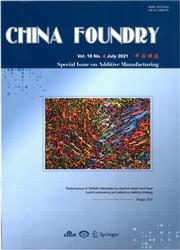Effect of heat treatment on microstructure and mechanical properties of Ti-containing low alloy martensitic wear-resistant steel
IF 2.3
3区 材料科学
Q2 Materials Science
引用次数: 0
Abstract
Effects of quenching temperature and cooling conditions (water cooling and 10% NaCl cooling) on microstructure and mechanical properties of a 0.2%Ti low alloy martensitic wear-resistant steel used for die casting ejector plate were investigated. The results show that lath martensite can be obtained after austenitizing in the range of 860–980 °C and then water cooling. With an increase in austenitizing temperature, the precipitate content gradually decreases. The precipitates are mainly composed of TiC and Ti4C2S2, and their total content is between 1.15wt.% and 1.64wt.%. The precipitate phase concentration by water-cooling is higher than that by 10% NaCl cooling due to the lower cooling rate of water cooling. As the austeniting temperature increases, the hardness and tensile strength of both water cooled and 10% NaCl cooled steels firstly increase and then decrease. The experimental steel exhibits the best comprehensive mechanical properties after being austenitized at 900 °C, cooled by 10% NaCl, and then tempered at 200 °C. Its hardness, ultimate tensile strength, and wear rate reach 551.4 HBW, 1,438.2 MPa, and 0.48×10−2 mg·m−1, respectively.热处理对含ti低合金马氏体耐磨钢组织和力学性能的影响
研究了淬火温度和冷却条件(水冷和10% NaCl冷却)对压铸顶板用0.2%Ti低合金马氏体耐磨钢组织和力学性能的影响。结果表明:在860 ~ 980℃范围内奥氏体化后,可得到板条马氏体;随着奥氏体化温度的升高,析出相含量逐渐降低。析出相主要由TiC和Ti4C2S2组成,总含量在1.15wt之间。%和1.64 %。由于水冷的冷却速率较低,水冷的析出相浓度高于10% NaCl冷却的析出相浓度。随着奥氏体温度的升高,水冷钢和10% NaCl冷却钢的硬度和抗拉强度均先升高后降低。实验钢经900℃奥氏体化、10% NaCl冷却、200℃回火后,综合力学性能最佳。其硬度为551.4 HBW,极限抗拉强度为1438.2 MPa,磨损率为0.48×10−2 mg·m−1。
本文章由计算机程序翻译,如有差异,请以英文原文为准。
求助全文
约1分钟内获得全文
求助全文
来源期刊

China Foundry
工程技术-冶金工程
CiteScore
2.10
自引率
25.00%
发文量
1646
审稿时长
3.0 months
期刊介绍:
China Foundry, published bimonthly to a worldwide readership, mainly reports on advanced scientific and technical achievements, applied technology, production successes, management and leadership, recent developments and industry information in the foundry field. Coverage encompasses all casting technologies and includes, but is not limited to, novel and net shape casting technologies; casting alloy design and modification; control of nucleation, solidification and microstructure & mechanical properties; computer aided design; rapid prototyping; mold making, mold materials and binders; mold and gating design; melting and liquid-metal treatment and transport; modeling and simulation of metal flow and solidification; post-casting treatments; quality control and non-destructive testing; process automation and robotics; and safety and environmental issues.
 求助内容:
求助内容: 应助结果提醒方式:
应助结果提醒方式:


